- Bestell-Nr. Artikelname Informationen
-
GC31523
Peptide YY (PYY) (3-36), human (Peptide YY (3-36))
Peptid YY (PYY) (3-36), human (Peptid YY (3-36)) ist ein Darmhormonpeptid, das als Y2-Rezeptoragonist wirkt, um den Appetit zu reduzieren.
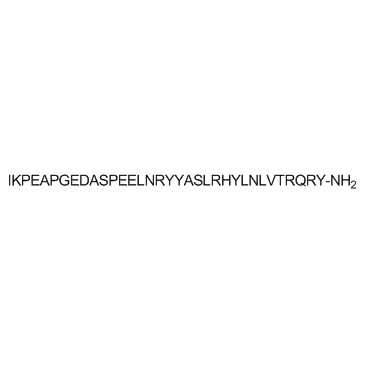
-
GC44598
Peptide YY (human) (trifluoroacetate salt)
Peptide Tyrosine Tyrosine
Peptide YY (PYY) is a 36-amino acid peptide and anorectic gut hormone agonist for the neuropeptide Y receptors Y1, Y2, Y5, and Y6 with EC50 values of 0.7, 0.58, 1, and 0.8 nM, respectively, for supression of forskolin-induced cAMP accumulation.
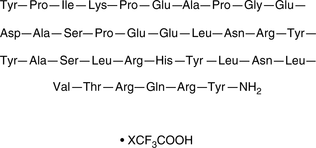
-
GC72259
Peptide A5K
Peptide A5K (INF7-A5K-TAT) is an RNP delivery peptide that delivers CRISPR RNPs to T cells.

-
GC63855
Peptide YY (PYY) (3-36), porcine TFA
Peptid YY (PYY) (3-36), Schweine-TFA ist ein Darmhormonpeptid, das als Y2-Rezeptoragonist wirkt, um den Appetit zu reduzieren.

-
GC36874
Peptide YY (PYY) (3-36), human TFA
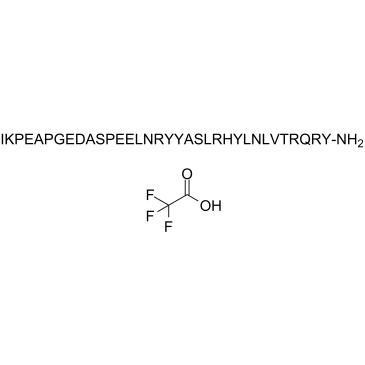
-
GC72139
Peptide5 TFA
Peptide5 TFA, a connexin 43 mimetic peptide, reduces animals swelling, astrogliosis, and neuronal cell death after spinal cord injury.

-
GC63141
Peptide 74
Peptid 74 ist ein synthetisches Peptid, das die ProdomÄnensequenz von Matrixmetalloproteinase (MMP) enthÄlt. Peptid 74 hemmt die aktivierte Form der 72-kDa-Typ-IV-Kollagenase in vitro.

-
GC32335
Peptide T TFA
Peptid T (TFA) ist ein Octapeptid aus der V2-Region von HIV-1 gp120.
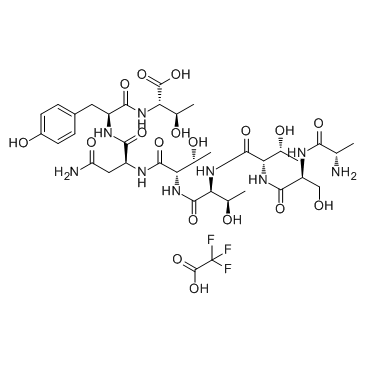
-
GC32309
Peptide T
Peptid T ist ein Octapeptid aus der V2-Region von HIV-1 gp120.
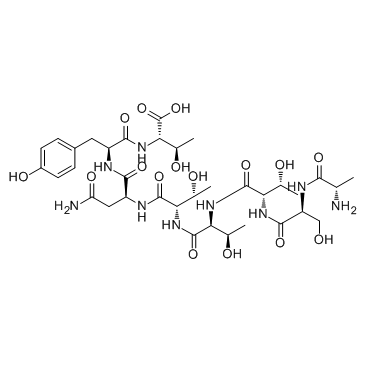
-
GC31767
Peptide 401
Peptid 401, ein starker Mastzell-Degranulationsfaktor aus Bienengift, unterdrÜckt die erhÖhte GefÄßpermeabilitÄt aufgrund der intradermalen Injektion verschiedener Spasmogene der glatten Muskulatur (Histamin und 5-HT).
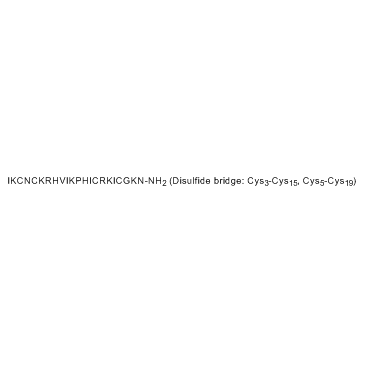
-
GP10131
Peptide YY(3-36), PYY, human
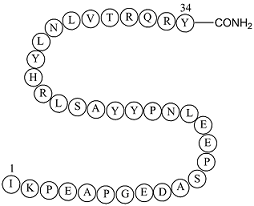
-
GC36873
Peptide C105Y
Peptid C105Y, ein synthetisches und zellgÄngiges Peptid, das auf der AminosÄuresequenz basiert, die den Resten 359-374 von α1-Antitrypsin entspricht, verstÄrkt die Genexpression von DNA-Nanopartikeln.

-
GC52502
Peptide YY (3-36) (trifluoroacetate salt)
Pancreatic Peptide YY, Peptide Tyrosine Tyrosine
A satiety hormone
-
GA23355
Peptide Lv (rat)
Peptide Lv has been discovered via a computational bioinformatics-based screening process. The neuropeptide is expressed in retinal photoreceptor layer, hippocampus, olfactory bulb, cerebellum, cerebral cortex, lung, spleen, liver and intestine. Peptide Lv enhances L-type voltage-gated calcium channel (L-VGCC) currents in retinal photoreceptors.
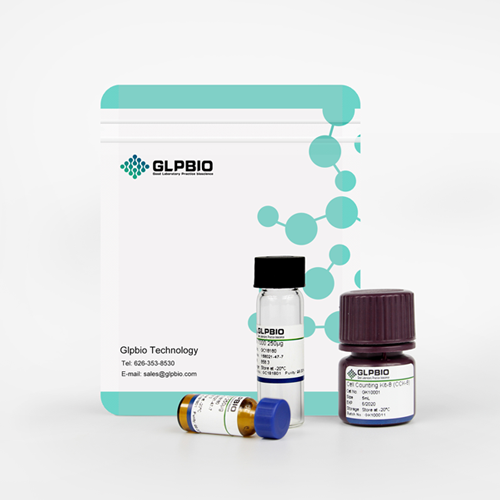
-
GC63347
Peptide 78
Peptid 78, ein chemotaktisches Zytokin, ein 78 AminosÄuren langes Proteinmitglied der IL-8- oder C-X-C-Chemokin-Supergenfamilie.

-
GC30452
Peptide YY (PYY), human
Peptide Tyrosine Tyrosine
Peptid YY (PYY) ist ein Darmhormon, das den Appetit reguliert und die Sekretion der BauchspeicheldrÜse hemmt.
-
GC30233
Peptide M
Peptid M ist eine synthetische AminosÄure (18 AminosÄuren lang, die den AminosÄurepositionen 303-322 des Rinder-S-Antigens entsprechen: DTNLASSTIIKEGIDKTV), die in der Lage ist, experimentelle Autoimmun-Uveitis bei Affen und Hartley-Meerschweinchen sowie Lewis-Ratten zu induzieren .
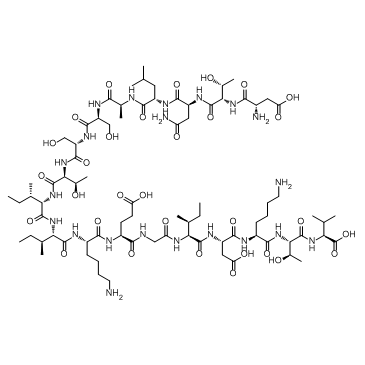
-
GA23356
Peptide WE-14
WE-14, a chromogranin A-derived peptide, was isolated from a human ileal carcinoid tumor. Its sequence WSKMDQLAKELTAE is highly conserved in many mammalian species and flanked by typical processing sites. Such factors would indicate a potential physiological role for peptide WE-14.

-
GA23357
Peptide YY (13-36) (canine, mouse, porcine, rat)
This C-terminal fragment was shown to suppress the noradrenaline release from sympathetic nerve endings. It thereby mimics the effects of PYY and NPY at presynaptic (Y?) receptors. The peptide was also able to compete with NPY for essentially all binding sites in rat brain.

-
GA23358
Peptide YY (canine, mouse, porcine, rat)

-
GC50439
Peptide5
Peptid5, ein Connexin 43-mimetisches Peptid, reduziert Schwellungen, Astrogliose und neuronalen Zelltod nach einer RÜckenmarksverletzung bei TierenIn Vitro: Peptid5 reduziert signifikant den Grad der RÜckenmarksverletzung (SCI) in einem Nagetier-Ex-vivo-Modell.

-
GC30535
Transdermal Peptide (TD 1 (peptide))
Transdermal Peptide (TD 1 (peptide)), consisting of 11 amino acids, is the first transdermal enhancing peptide discovered by phage display.

-
GC31172
δ-Sleep Inducing Peptide (Delta-Sleep Inducing Peptide)
δ-Sleep Inducing Peptide (Delta-Sleep Inducing Peptide) ist ein Neuropeptid mit antioxidativen und anxiolytischen Eigenschaften.
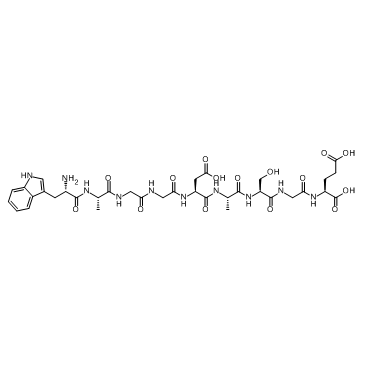
-
GC31527
C-Peptide, dog (C-Peptide (dog))
C-Peptide (dog)
C-Peptid, Hund (C-Peptid (Hund)) ist ein Bestandteil von Proinsulin, das zusammen mit Insulin aus Betazellen der BauchspeicheldrÜse ins Blut freigesetzt wird.
-
GC35123
3X FLAG peptide TFA
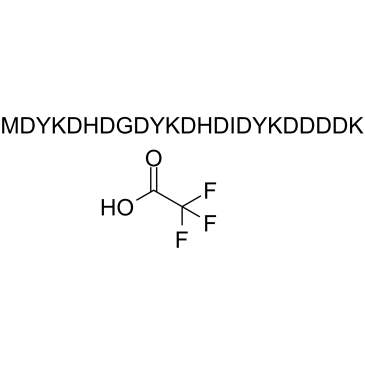
-
GC34397
Sphistin Synthetic Peptide(12-38,Fitc in N-Terminal-Fluorescently Labeled Peptide)
Synthetisches Sphistin-Peptid (12-38, Fitc in N-terminal fluoreszierend markiertem Peptid) ist ein verkÜrztes Fragment des synthetischen Sphistin-Peptids, das eine starke antimikrobielle AktivitÄt zeigt.

-
GP10149
3X FLAG Peptide
H-Met-Asp-Tyr-Lys-Asp-His-Asp-Gly-Asp-Tyr-Lys-Asp-His-Asp-Ile-Asp-Tyr-Lys-Asp-Asp-Asp-Asp-Lys-OH
Synthetisches Peptid-Tag
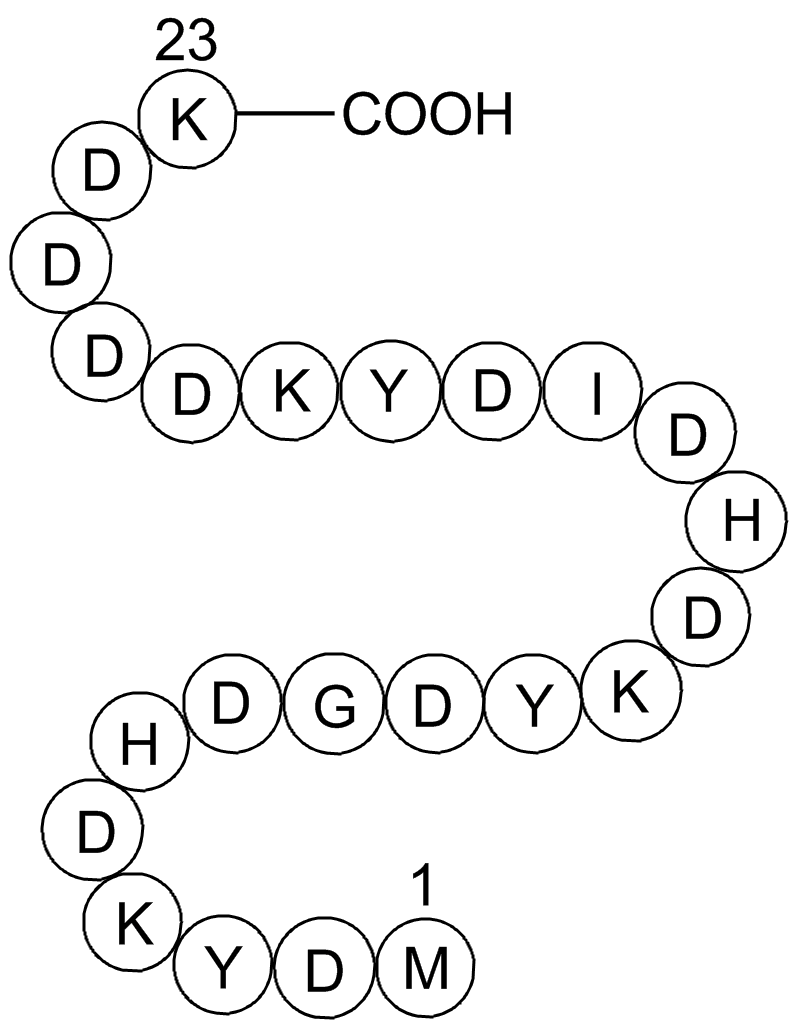
-
GC30285
Eledoisin (Eledone peptide)
ELD 950, Moschatin
A neurokinin receptor agonist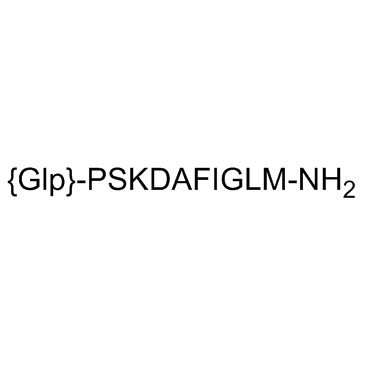
-
GC52376
BMP2-derived Peptide (trifluoroacetate salt)
Bone Morphogenic Protein 2-derived Peptide, KIPKASSVPTELSAISTLYL-NH2
A synthetic peptide
-
GC44655
PKCε Inhibitor Peptide
Protein Kinase Cɛ Inhibitor Peptide,ɛV1-2
PKCε Inhibitorpeptid (ε-V1-2), ein von PKC&7#949; abgeleitetes Peptid, ist ein selektives PKCε Inhibitor.
-
GC45382
Amyloid-β (1-28) Peptide (human) (trifluoroacetate salt)
Aβ (1-28), Aβ28

-
GP10091
Vasonatrin Peptide (1-27)
H2N-Gly-Leu-Ser-Lys-Gly-Cys-Phe-Gly-Leu-Lys-Leu-Asp-Arg-Ile-Gly-Ser-Met-Ser-Gly-Leu-Gly-Cys-Asn-Ser-Phe-Arg-Tyr-OH
Vasonatrin Peptide (1-27), (C124H198N36O36S3), a peptide with the sequence H2N-GLSKGCFGLKLDRIGSMSGLGCNSFRY-OH, MW= 2865.4.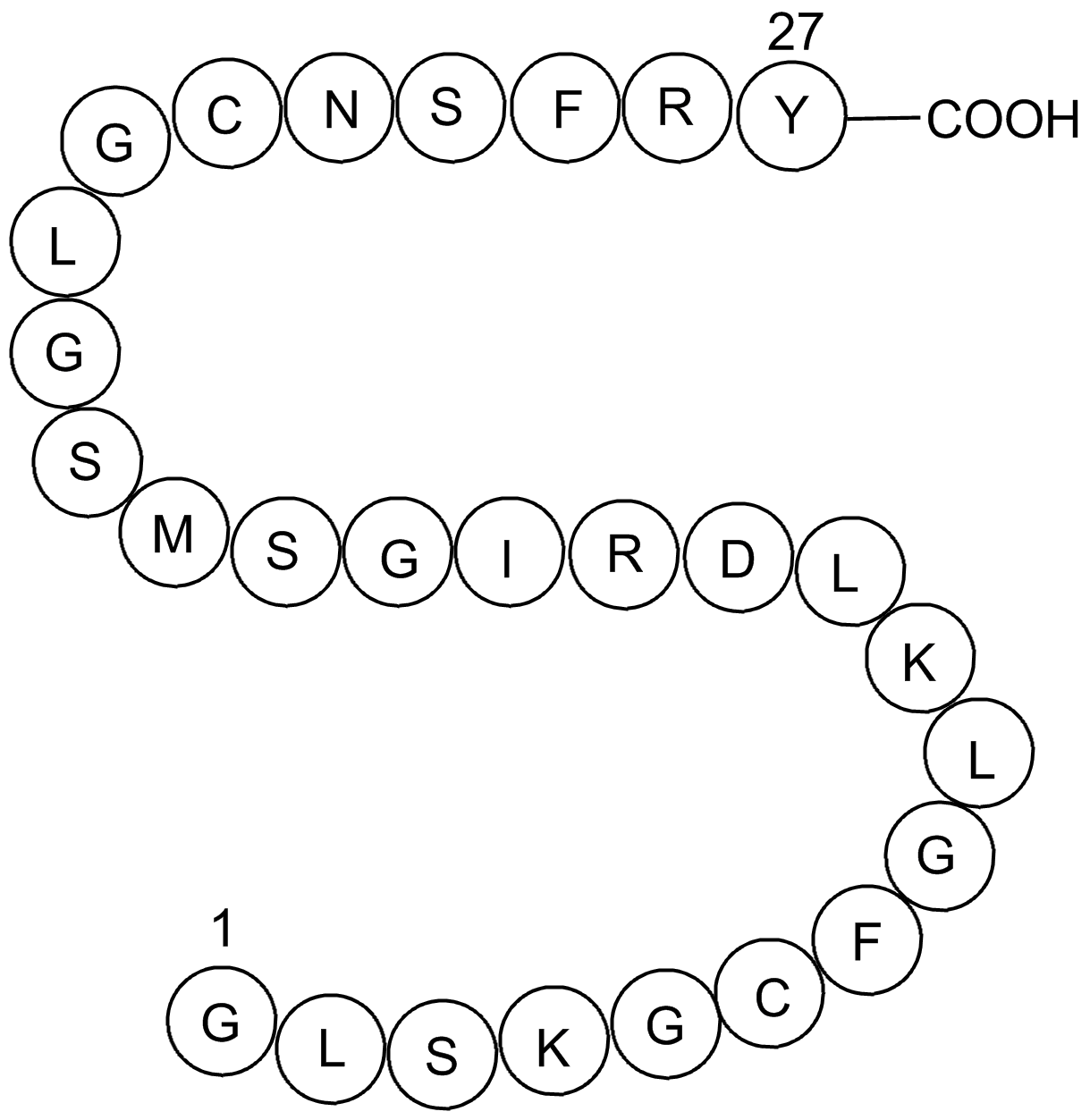
-
GP10049
Amyloid Beta-Peptide (12-28) (human)
Amyloid Beta-Peptide (12-28) (human) is a peptide fragment of amyloid beta protein (1-42) (Aβ (1-42)).
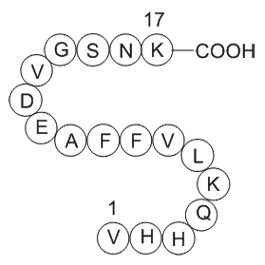
-
GP10082
Amyloid Beta-peptide (25-35) (human)
Amyloid-Beta-Peptid (25-35) (human) ist ein Fragment des Alzheimer Amyloid-Beta-Peptids, das neurotoxische Effekte hat.
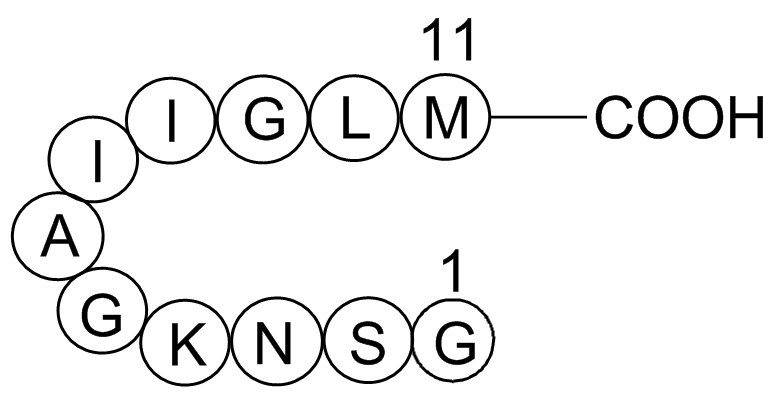
-
GC52385
Myelin Basic Protein (85-99) Peptide Antagonist (trifluoroacetate salt)
EKPKVEAYKAAAAPA-OH, MBP (85-99) Peptide Antagonist
An MBP (85-99) antagonist
-
GC66061
Competence-Stimulating Peptide-2 (CSP-2)
Competence-Stimulating Peptide-2 (CSP-2) ist ein Quorum-Sensing-Signalpeptid, das von Streptococcus pneumoniae produziert wird. ComD2 ist ein kompatibler Rezeptor von Competence-Stimulating Peptide-2 (CSP-2) mit einem EC50-Wert von 50,7 nM.

-
GC52361
AMARA Peptide (trifluoroacetate salt)
AMARAASAAALARRR-OH, H-Ala-Met-Ala-Arg-Ala-Ala-Ser-Ala-Ala-Ala-Leu-Ala-Arg-Arg-Arg-OH
A peptide substrate for AMPK
-
GC52196
RGD Peptide
GRGDNP, HGlyArgGlyAspAsnProOH
RGD-Peptid wirkt als Inhibitor von Integrin-Liganden-Wechselwirkungen und spielt eine wichtige Rolle bei ZelladhÄsion, Migration, Wachstum und Differenzierung.
-
GC49883
DAPK Substrate Peptide (trifluoroacetate salt)
Death-associated Protein Kinase Substrate Peptide
A DAPK1 peptide substrate
-
GC48346
DYKDDDDK Peptide (trifluoroacetate salt)
DYKDDDDK Epitope, DYKDDDDK Octapeptide, DYKDDDDK Tag

-
GC37524
RGD peptide (GRGDNP) TFA
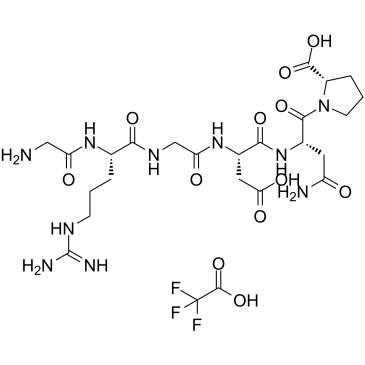
-
GC44806
Ras Inhibitory Peptide
Sos SH3 Domain Inhibitor
Son of sevenless homolog 1 (Sos1) is a guanine nucleotide exchange factor (GEF) that directs the exchange of Ras-GDP to Ras-GTP by binding to SH3 domains of the growth factor receptor-bound protein 2 (Grb2), leading to the activation of ERK.
-
GC34274
SPACE peptide
SPACE-Peptid ist ein hautpenetrierendes Peptid (SPPs).

-
GC91470
Fyn Peptide (410-430) (human, mouse, rat, porcine, bovine) (trifluoroacetate salt)
Src (409-429) (human, rat); Src (408-428) (mouse)
Das Fyn-Peptid (410-430) ist ein Peptidfragment der Src-Familie nicht-rezeptorischer Tyrosinkinase Fyn, das Tyr420 enthält und bei Aktivierung von vollständigem Fyn einer Autophosphorylierung unterzogen wird.

-
GC91462
Abl Substrate Peptide (trifluoroacetate salt)
Abl-Substrat-Peptid ist ein Peptidsubstrat für die Tyrosinkinase Abl.

-
GC91441
RGD Peptide (trifluoroacetate salt)
GRGDNP; H-
Gly- Arg- Gly- Asp- Asn- Pro- OH Das RGD-Peptid ist eine synthetische Verbindung, die aus dem Arginin-Glycin-Aspartat-Motiv besteht und in Studien zur Zelladhäsion, Migration, Wachstum und Differenzierung umfangreich eingesetzt wurde, um Integrin-Liganden-Interaktionen zu hemmen.

-
GC91027
EGFRvIII Peptide (trifluoroacetate salt)
Ein EGFRvIII-Peptidfragment

-
GC90733
Klotho-derived Peptide 1 (56-87) (human) (trifluoroacetate salt)
Ein TGF-β-störendes Peptid

-
GC90635
RAD17-derived Peptide (trifluoroacetate salt)
Ein Peptidsubstrat für ATR

-
GC90620
N-Peptide (trifluoroacetate salt)
Ein Peptid

-
GC90600
Tat-NTS Peptide (trifluoroacetate salt)
Ein zellpenetrierendes Peptid

-
GC90561
Gastric Inhibitory Peptide (22-51) (human) (trifluoroacetate salt)
Ein pro-atherogenes Peptid.

-
GC90558
Myelin Basic Protein Peptide Antagonist (trifluoroacetate salt)
Ein MBP-Antagonist

-
GC90547
Gastric Inhibitory Peptide 1 (3-42) (human) (trifluoroacetate salt)
Ein Peptidfragment von GIP und ein GIP-Rezeptor-Antagonist

-
GC90546
MOG Peptide (human, bovine) (acetate)
Ein endogenes Myelinscheiden-Peptid

-
GC90543
EGFR Peptide (human, mouse) (myristoylated) (trifluoroacetate salt)
Ein PKC-Inhibitor

-
GC90542
EGFR Peptide (human, mouse) (trifluoroacetate salt)
Ein Peptid-Substrat von PKC

-
GC90534
Gastric Inhibitory Peptide (1-39) (porcine) (trifluoroacetate salt)
Ein Induktor der Insulinsekretion

-
GC90529
Myelin Basic Protein Peptide (mouse, bovine) (trifluoroacetate salt)
Ein Peptid-Substrat für PKC

-
GC90286
Amyloid-β (1-28) Peptide (human) (trifluoroacetate salt)
Ein 28-aminosäurelanges Amyloid-β-Proteinfragment.

-
GC70187
δ-Sleep Inducing Peptide acetate
Delta-Sleep Inducing Peptide acetate
δ-Schlaf-induzierendes Peptidacetat ist ein Neuropeptid mit antioxidativen und angsthemmenden Eigenschaften.
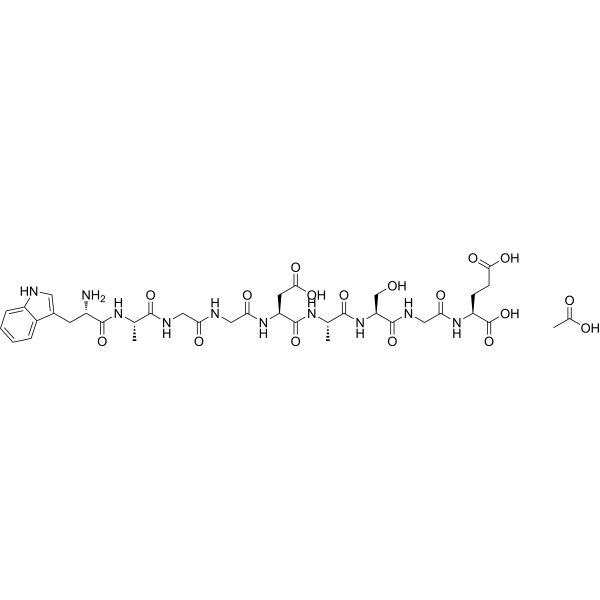
-
GP10150
FLAG tag Peptide
H-Asp-Tyr-Lys-Asp-Asp-Asp-Asp-Lys-OH
FLAG tag Peptide ist ein 8-Peptid (Asp-Tyr-Lys-Asp-Asp-Asp-ASP-ASP-Lys), das eine intestinale Kinase-Beschränkungsstelle enthält.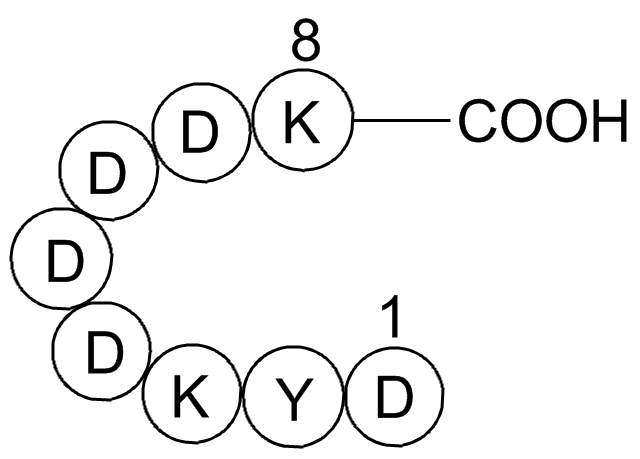
-
GP10104
S6 Kinase Substrate Peptide 32
H2N-Lys-Glu-Ala-Lys-Glu-Lys-Arg-Gln-Glu-Gln-Ile-Ala-Lys-Arg-Arg-Arg-Leu-Ser-Ser-Leu-Arg-Ala-Ser-Thr-Ser-Lys-Ser-Gly-Gly-Ser-Gln-Lys-OH
Measures the activity of kinases that phosphorylate ribosomal protein S6.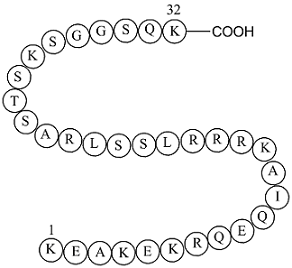
-
GP10108
EGF-R (661-681) T669 Peptide
H2N-Lys-Arg-Glu-Leu-Val-Glu-Pro-Leu-Thr-Pro-Ser-Gly-Glu-Ala-Pro-Asn-Gln-Ala-Leu-Leu-Arg-OH
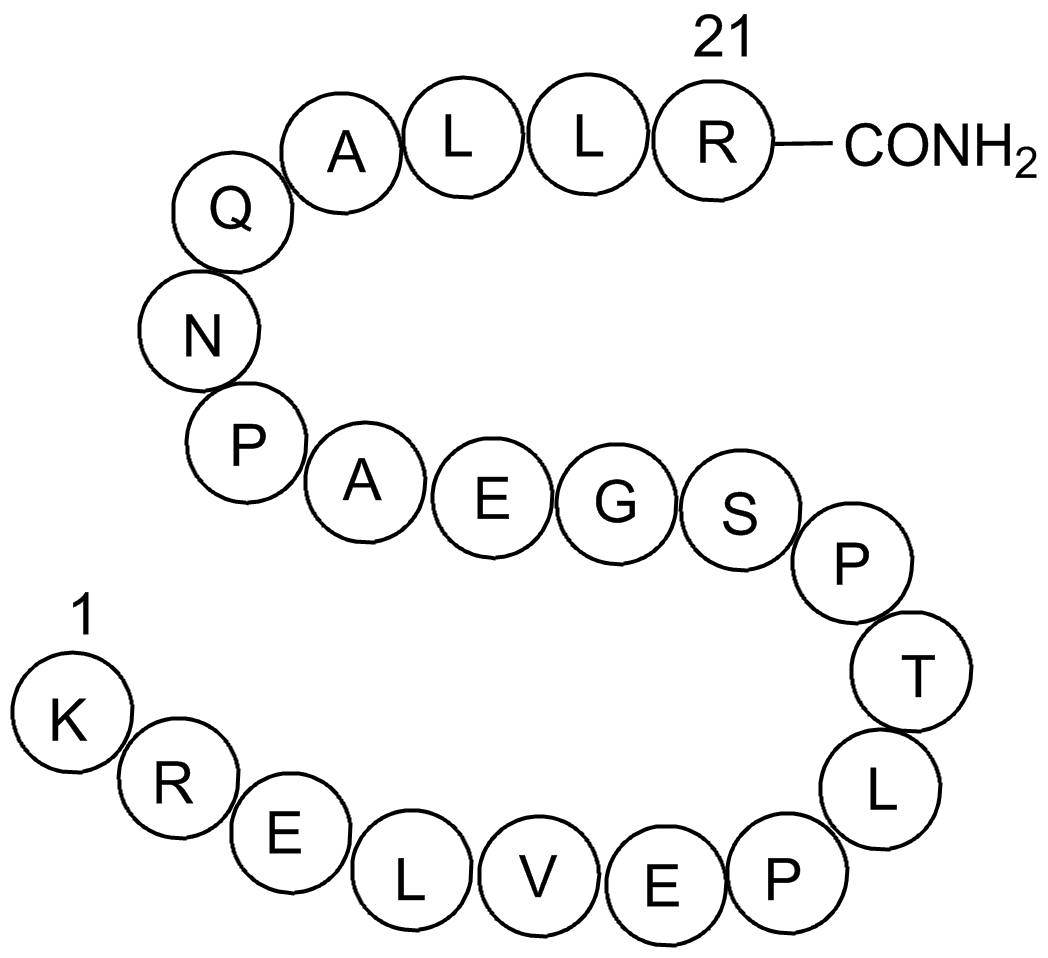
-
GP10011
Nitric Oxide Synthase (599-613) Blocking Peptide, Bovine Endothelial Cell
Ac-Pro-Tyr-Asn-Ser-Ser-Pro-Arg-Pro-Glu-Gln-His-Lys-Ser-Tyr-Lys-Cys-OH

-
GP10098
Cdk2/Cyclin Inhibitory Peptide I
H2N-Tyr-Gly-Arg-Lys-Lys-Arg-Arg-Gln-Arg-Arg-Arg-Gly-Pro-Val-Lys-Arg-Arg-Leu-Phe-Gly-OH
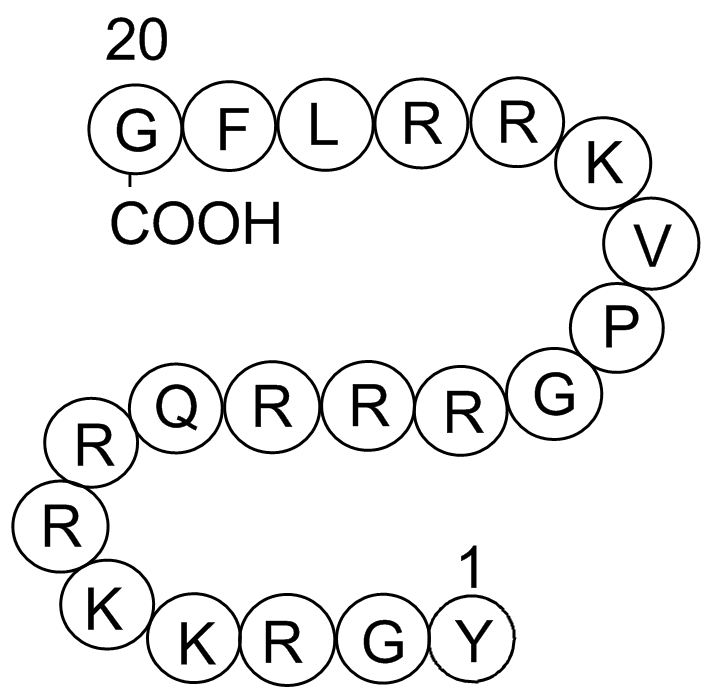
-
GP10094
Amyloid β-peptide (10-35), amide
H2N-Tyr-Glu-Val-His-His-Gln-Lys-Leu-Val-Phe-Phe-Ala-Glu-Asp-Val-Gly-Ser-Asn-Lys-Gly-Ala-Ile-Ile-Gly-Leu-Met-NH2

-
GP10147
Ribosomal protein L3 peptide (202-222) amide
H2N-Met-Ser-His-Arg-Lys-Tyr-Glu-Ala-Pro-Arg-His-Gly-His-Leu-Gly-Phe-Leu-Pro-Arg-Lys-Arg-amide

-
GP10042
Rhodopsin peptide
H2N-Val-Ser-Lys-Thr-Glu-Thr-Ser-Gln-Val-Ala-Pro-Ala-OH

-
GP10127
Cadherin Peptide, avian
H2N-Leu-Arg-Ala-His-Ala-Val-Asp-Val-Asn-Gly-amide
Role in cell adhesion

-
GP10095
Epidermal Growth Factor Receptor Peptide (985-996)
H2N-Asp-Val-Val-Asp-Ala-Asp-Glu-Tyr-Leu-Ile-Pro-Gln-OH
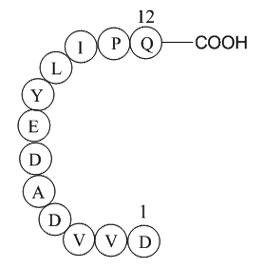
-
GP10089
Platelet Membrane Glycoprotein IIB Peptide (296-306)
H2N-Thr-Asp-Val-Asn-Gly-Asp-Gly-Arg-His-Asp-Leu-OH
Inhibits platelet aggregation
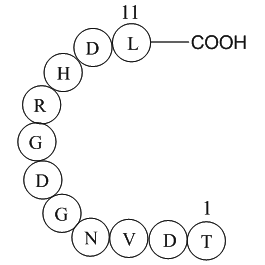
-
GP10046
Amyloid Precursor C-Terminal Peptide
H2N-Gly-Tyr-Glu-Asn-Pro-Thr-Tyr-Lys-Phe-Phe-Glu-Gln-Met-Gln-Asn-OH
For beta amyloid generation

-
GP10118
Amyloid Beta-Peptide (1-40) (human)
Amyloid β-Peptid (1-40) (human), (C194H295N53O58S1), ist ein Peptid mit der Sequenz H2N-DAEFRHDSGYEVHHQKLVFFAEDVGSNKGAIIGLMVGGVVIA-OH, MW= 4329.8. Amyloid-Beta (Aβ oder Abeta) ist ein Peptid von 36–43 Aminosäuren, das aus dem Amyloid-Vorläuferprotein verarbeitet wird.
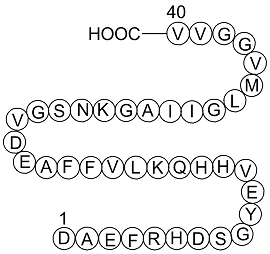
-
GP10022
Dynamin inhibitory peptide
Gln-Val-Pro-Ser-Arg-Pro-Asn-Arg-Ala-Pro

-
GP10057
Amyloid β-Peptide (10-20) (human)
Tyr-Glu-Val-His-His-Gln-Lys-Leu-Val-Phe-Phe
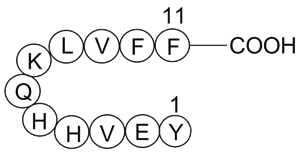
-
GA21428
Erythropoietin Mimetic Peptide Sequence 20
Peptide mimetic of erythropoietin (EPO). EMP-20 has been described to be an excellent starting point for the design of compounds with erythropoietin (EPO) mimetic activity and can serve as a minimal model for an EPO receptor antagonist.

-
GC62069
pm26TGF-β1 peptide TFA
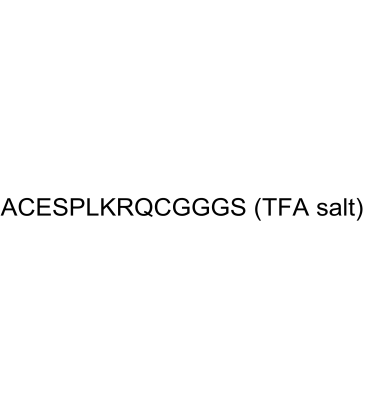
-
GC62068
pm26TGF-β1 peptide
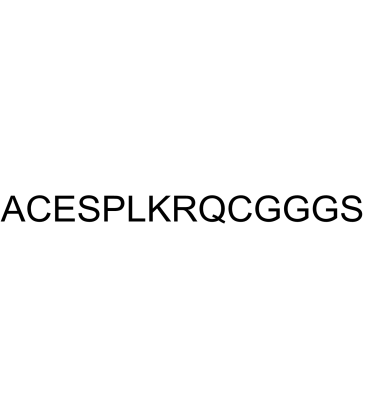
-
GC38520
PTD-p65-P1 Peptide TFA
PTD-p65-P1-Peptid TFA ist ein potenter, selektiver Inhibitor des nuklearen Transkriptionsfaktors NF-κB und leitet sich von der p65-Untereinheit der NF-κB-AminosÄurereste 271-282 ab, die selektiv die NF-κB-Aktivierung, die durch verschiedene EntzÜndungsstimulationen induziert wird, herunter hemmt -regulieren die NF-κB-vermittelte Genexpression und regulieren die Apoptose hoch.
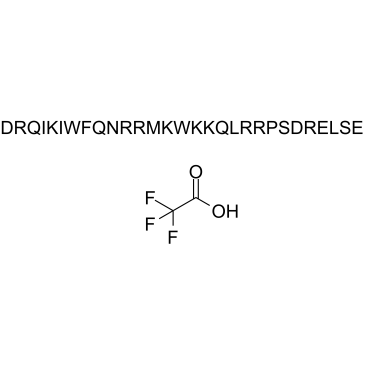
-
GC60095
Brain Natriuretic Peptide (1-32), rat acetate
BNP (1-32), rat acetate
Brain Natriuretic Peptide (1-32), Rattenacetat (BNP (1-32), Rattenacetat) ist ein Polypeptid aus 32 AminosÄuren, das von den Ventrikeln des Herzens als Reaktion auf ÜbermÄßige Dehnung der Herzmuskelzellen (Kardiomyozyten) ausgeschieden wird .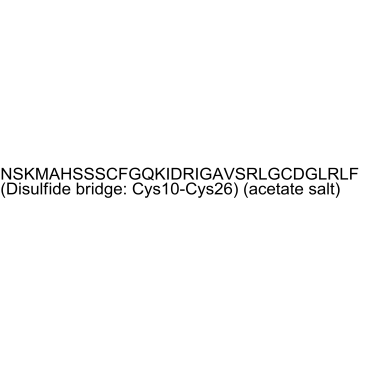
-
GC36467
LL-37 scrambled peptide
LL-37 Scrambled Peptide ist eine verschlÜsselte Version des antimikrobiellen Cathelicidin-Peptids LL-37.
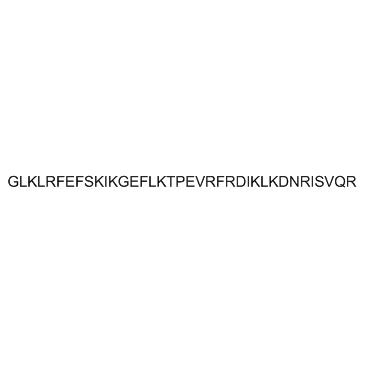
-
GC36150
Glucagon-Like Peptide (GLP) I (7-36), amide, human
Glucagon-Like Peptide (GLP) I (7-36), Amid, human, ist ein physiologisches Inkretinhormon, das die Insulinsekretion stimuliert.
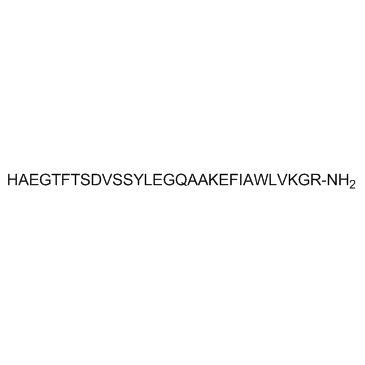
-
GC36041
Fibronectin Adhesion-promoting Peptide
Heparin Binding Peptide
Fibronectin Adhesion-promoting Peptide (Trp-Glu-Pro-Pro-Arg-Ala-Arg-Ile) hat sowohl medizinisches Interesse als auch eine gut charakterisierte Struktur.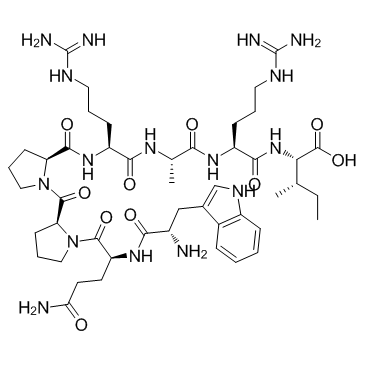
-
GC34233
PACAP-Related Peptide (PRP), human
PACAP-Related Peptide (PRP), human, ist eine 29-AminosÄuren-Region des PACAP-VorlÄuferproteins.

-
GC34023
Atrial Natriuretic Peptide (ANP) (1-28), human, porcine
ANF, ANP, Atrial Natriuretic Factor, α-Atriopeptin (human)
Atriales natriuretisches Peptid (ANP) (1-28), Mensch, Schwein (Atriales natriuretisches Peptid (ANP) (1-28), Mensch, Schwein) ist ein 28-AminosÄuren-Hormon, das normalerweise vom menschlichen Herzen produziert und ausgeschieden wird als Reaktion auf Herzverletzung und mechanische Dehnung.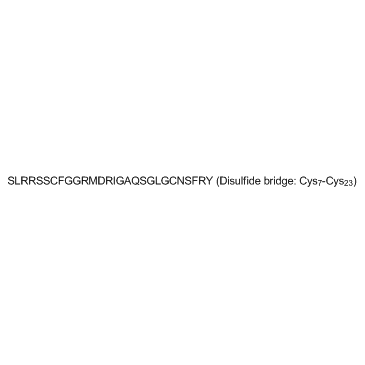
-
GC33690
Crustacean Cardioactive Peptide CCAP
Crustacean Cardioactive Peptide CCAP ist ein hoch konserviertes, amidiertes zyklisches Nonapeptid, das zuerst aus den Perikardorganen der Strandkrabbe Carcinus maenas isoliert wurde, wo es eine Rolle bei der Regulierung des Herzschlags spielt; Crustacean Cardioactive Peptide CCAP moduliert auch die neuronale Aktivität in anderen Arthropoden.
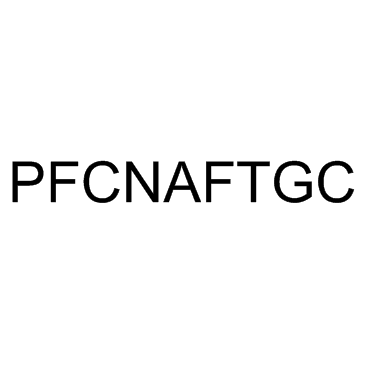
-
GC33600
OVA Peptide (257-264) TFA
Ser-Ile-Ile-Asn-Phe-Glu-Lys-Leu, SIINFEKL, OVA (257-264)
OVA-Peptid (257–264) TFA ist ein auf Klasse I (Kb) beschränktes Peptidepitop von OVA, ein oktameres Peptid, das von Ovalbumin stammen kann, das durch das Klasse-I-MHC-Molekül H-2Kb präsentiert wird.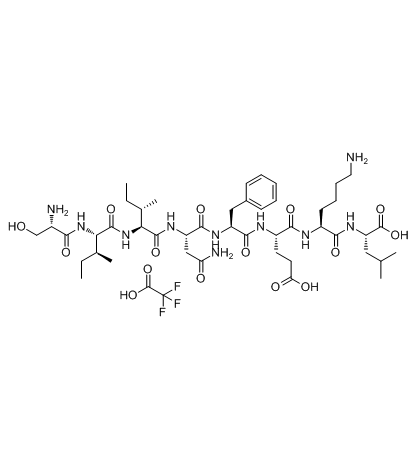
-
GC33448
OVA Peptide 257-264
OVA-Peptid 257-264 ist ein auf Klasse I (Kb) beschränktes Peptidepitop von OVA, ein oktameres Peptid, das von Ovalbumin stammen kann, das durch das Klasse-I-MHC-Molekül H-2Kb präsentiert wird.
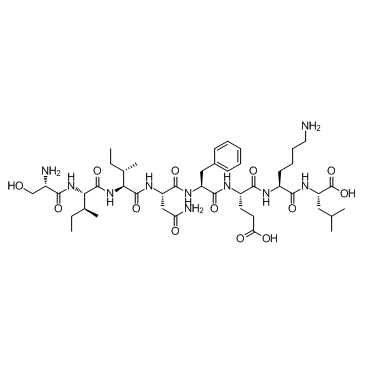
-
GC32612
BNP-45 rat (Brain natriuretic peptide-45 rat)
BNP-45 Ratte (Brain Natriuretic Peptide-45 Ratte) (BNP-45, Ratte) ist eine zirkulierende Form von Rattenhirn-natriuretischem Peptid, das aus Rattenherzen isoliert wurde, mit starker hypotensiver und natriuretischer Potenz.

-
GC32589
Brain Natriuretic Peptide (BNP) (1-32), rat
Brain Natriuretic Peptide (BNP) (1-32), Ratte (BNP (1-32), Ratte) ist ein 32 AminosÄuren langes Polypeptid, das von den Herzkammern als Reaktion auf eine ÜbermÄßige Dehnung der Herzmuskelzellen (Kardiomyozyten) ausgeschieden wird.
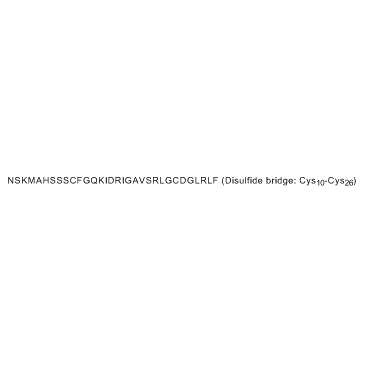
-
GC32299
Bombinin-Like Peptide BLP-1
Bombinin-Like Peptide BLP-1 ist ein antimikrobielles Peptid der Bombina-Spezies.
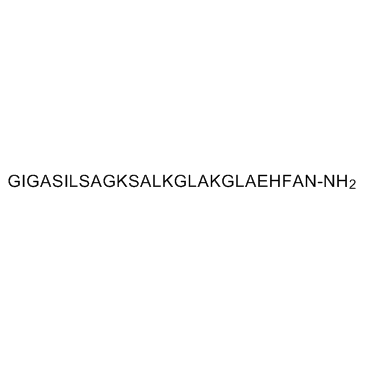
-
GC15099
Autocamtide-2-related inhibitory peptide
Autocamtide-2-related inhibitory peptide ist ein hochspezifischer und potenter Inhibitor von CaMKII mit einem IC50 von 40 nM.

-
GC26392
MANS peptide TFA
MANS peptide TFA is the TFA salt form of MANS peptide. MANS peptide TFA is an inhibitor of MARCKS, which competitively binds to MARCKS on the cell membrane, thereby inhibiting mucin secretion and tumor metastasis.

-
GC35334
Amyloid β Peptide (42-1)(human)
Amyloid β Peptid (42-1) (Mensch) ist die inaktive Form von Amyloid β Peptid (1-42).

-
GC72299
BMP2-derived peptide
BMP2-derived peptide is a functional motif from positions 73 to 92 of the amino acid sequence of BMP-2. BMP2-derived peptide promotes osteogenic differentiation of bone marrow stromal cells (BMSCs) and enhances bone regeneration.

-
GC72277
IRS1-derived peptide
IRS1-derived peptide is a biological active peptide.

-
GC72270
OVA-T4 Peptide
OVA-T4 Peptide (SIITFEKL, OVA (257-264) Variant) is a biological active peptide.

-
GC72268
IRBP derived peptide, R16 acetate
IRBP derived peptide, R16 is a biological active peptide.

-
GC72267
Dby HY Peptide (608-622), mouse
Dby Peptide (608-622), mouse is a biological active peptide.

Zielscheibe:
Histones/Histone Peptides
Neuropeptide FF/AF Receptors
Neuropeptide S Receptor
Formyl Peptide Receptors
Peptide Receptors
Cancer Biology Peptides
Neuroscience Peptides
Peptide Inhibitors and Substrate
Cell Penetrating Peptide
Natriuretic Peptide Receptors
Peptide Coupling Reagents
Isotope-Labeled Amino Acids & Peptides
Tag Peptides
Neuropeptides
Peptide Hormones
Peptides
B type Natriuretic Peptide
Polymerase (RNA) (DNA directed) Polypeptide
Kategorie:
Caspase
Aminopeptidase
ACE
Cathepsin
Elastase
HCV Protease
MMP
Thrombin
Other Proteases
Endogenous Metabolite
Mitochondrial Metabolism
Pyroptosis
Bax
Bcl-2 Family
p53
TNF-α
Other Apoptosis
PD-1/PD-L1 interaction
Histone Demethylases
Histone Methyltransferase
Epigenetic Reader Domain
Citrullination
Histones/Histone Peptides
Neuronal Metabolism
Bone Growth & Remodeling
Carbohydrate Metabolism
Cofactors & Vitamins
Dyslipidemias
Necrosis
Nutrient Sensing
Reproductive Biology
PKA
p38
JNK
cAMP
Broad Spectrum Protein Kinase Inhibitor
c-MET
Insulin Receptor
Src
Trk
DNA/RNA Synthesis
Casein Kinase
AMPK
GSK-3
S6 Kinase
Antibiotic
HBV
HCV
HIV
SARS-CoV
Antifungal
Arenavirus
Bacterial
Fungal
Parasite
Antiviral
Microtubule/Tubulin
Dynamin
ECM & Adhesion Molecules
Endomembrane System & Vesicular Trafficking
Proteolysis
Cytoskeleton & Motor Proteins
Autophagy
STAT
PKC
Integrin
PAR1
Neuropeptide FF/AF Receptors
Formyl Peptide Receptors
5-HT Receptor
Adrenergic Receptor
Apelin Receptor
Angiotensin Receptor
Bombesin Receptors
Bradykinin Receptors
Calcitonin and Related Receptors
Cannabinoid Receptor
CaSR
CCR
Chemokine Receptors
CXCR
Endothelin Receptor
Galanin Receptors
Ghrelin Receptors
GIP Receptor
Glucagon Receptor
Melanocortin (MC) Receptors
Motilin Receptor
Non-selective CRF
Neurotensin Receptors
NOP Receptor
NPY Receptors
Oxytocin Receptors
Peptide Receptors
Protease-Activated Receptors
Secretin Receptors
Urotensin-II Receptor
VIP Receptors
Neuromedin U Receptors
mAChR
Neurokinin Receptor
YAP
AMPAR
Calcium Channel
Pannexin-1
Potassium Channel
TRP Channel
Kainate Receptors
Na+/K+ ATPase
Cancer Biology Peptides
Tumor Microenvironment
Cell Migration & Metastasis
GnRH
Opioid Receptor
Thyroid hormone Receptor
TRH
Glucocorticoids & Mineralocorticoids
AChR
Alzheimer
Amyloid β
CGRP
DAPK
Gap Junction
GluR
Histamine Receptor
Neuroscience Peptides
CaMK
Behavioral Neuroscience
Neuroendocrinology
Neuroprotection
Ophthalmology
Pain Research
Diabetes
NAFLD & NASH
Obesity
Other Signal Transduction
Apoptosis
NF-κB
Interleukin Related
Complement System
IFNAR
STING
Reactive Oxygen Species
Glutathione
Adaptive Immunity
Allergy
Arthritis
Autoimmunity
Gastric Disease
Innate Immunity
Pulmonary Diseases
Acute Phase Reactants
Arrhythmia
Atherosclerosis
Chronic Kidney Disease
Coagulation & Hemostasis
Diabetic Nephropathy
Endothelium
Heart Failure
Hypertension
Myocardial Contractility
Myocardial Hypertrophy
Myocardial Infarction
Serum Proteins
Smooth Muscle Cells
Stroke
Thrombosis
Vasoconstriction
Vasodilation
Antioxidants
Carbohydrate Oxidation
Lipid Peroxidation
Pro-Oxidant Activity
Inhibitory Antibodies
Adenylate cyclase
Cell Penetrating Peptide
Cytokine
Enzyme Substrates / Activators
Fluorescent Probes
Glycoprotein
Guanylate Cyclase
MDR multidrug resistance
Myosin
Natriuretic Peptide Receptors
Nitric Oxide
PGC-1α
Renin
Tachykinin
Transcription Factors
Others
Cyclase
Negative Controls
Toxicology
Antiparasitics
Peptide Coupling Reagents
Amino Acids and Derivatives
Natural Products
Cyanine Dyes
Dyes, Stains & Indicators
Enzyme Substrates
Fluorescence
Biochemical Assay Reagents
Tag Peptides
Amyloid β protein
Neuropeptides
Peptide Hormones
Dengue
Yellow Fever
Food-Borne Illnesses
MRSA
Pneumonia
Tuberculosis
Candidiasis
Parasitic Diseases
Quorum Sensing
Macrophage Migration Inhibitory Factor
Superoxide Dismutase


